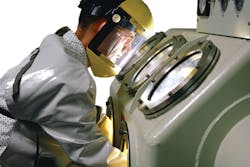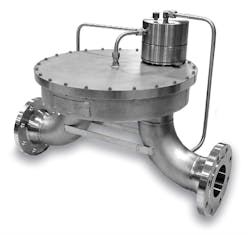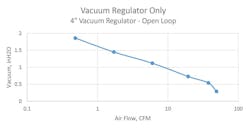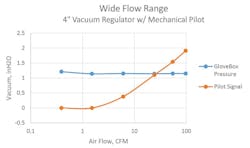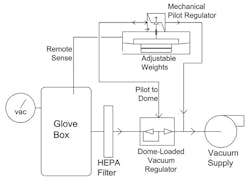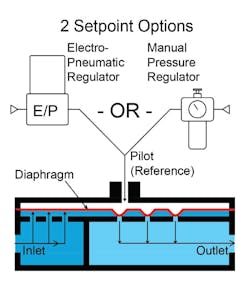Glovebox technology was first used in the 1940s to protect national defense researchers from hazardous materials. During the 1960s, NASA scientists used gloveboxes to examine rocks retrieved from the moon.
The American Glovebox Society reports that glovebox technology is rapidly expanding into more markets and being used in more diverse ways. In many of these applications, the pressure inside the glovebox must be strictly controlled, which can present multiple challenges when extreme conditions are combined with hazardous materials.
During the last three years, scientists at a major national science laboratory have worked with fluid engineers to develop an improved system to control air and nitrogen pressure in gloveboxes. The technology uses a large, sensitive vacuum regulator capable of reacting to pressure changes in milliseconds combined with a mechanical pilot regulator to direct the base regulator as necessary. This combination is capable of rapidly controlling pressure down to the range of 0.5 inches water column (inH2O) — about 1 mbar — even when the application involves wide flow rate ranges.
The challenge
Laboratory researchers struggled to balance conflicting demands as they designed a pressure control system for the glovebox. The system needed to maintain a precise vacuum at low flow rates. At the same time, it had to be fully capable of pulling large flow rates in the event of a glove rupture within the glovebox.
Specifically, in normal use with glove seals intact, the pressure control for this glovebox system is expected to perform reliably with only a low flow of inert nitrogen in the range of 1 cubic foot per minute (CFM) of gas flow. In the event of glove seal degradation, however, the system must maintain good control at much higher flows, such as 10 to 20 CFM. In the unexpected event of a total glove loss, the control system must provide control up to 100 CFM to prevent hazardous material from flowing out of the lost glove port.
These demands are complicated by the fact that a vacuum above approximately 1 inH2O is considered undesirable for glovebox use because it hampers the dexterity of the gloves used by laboratory operators.
Traditionally, demanding glovebox applications such as this one have used large pilot-actuated globe valves with springs. While this design is a successful standard solution for tank blanketing and other high-flow, low-pressure applications, it did not allow operators to meet the laboratory’s complicated precision requirements over time. The demands of accommodating the wide flow range and the low 1 inH2O pushed the limits of the globe valve’s spring design. As researchers conducted long-term experiments, they developed laborious in-house assembly and maintenance procedures to push the globe valve performance to the limits. Even with modifications, the spring design could not achieve the sensitive control action desired.
Multiple-orifice regulator improves accuracy and stability
Engineers recommended a new approach to vacuum regulation by specifying a product using a supple diaphragm as the only moving part.
The multiple-orifice vacuum regulator differs greatly from the traditional spring design. Instead of a single large valve seat, the vacuum regulator specified uses more than 200 parallel orifices sealed directly with a flexible diaphragm. The diaphragm is dome-loaded by air pressure on top of the diaphragm and controls the inlet pressure to closely equal this pilot pressure. The lightweight, supple diaphragm moves a few millimeters to modulate the vacuum regulator according to a fast force balance on the membrane. As a result, it reacts to changing pressure requirements in milliseconds.
Design details
Closed-loop control
The laboratory’s application requires a HEPA filter between the glovebox and the main vacuum regulator, which generates up to 1 to 2 inH2O differential pressure. This relatively large pressure drop rules out a single-pressure regulator design to control pressure downstream of the filter. As a result, remote sensing and closed-loop control are needed for the main vacuum regulator to sense and control the glovebox properly.
The fluid engineers specified a highly sensitive pilot regulator with a relatively large sensing area to monitor (remotely sense) the glovebox and rapidly adjust the pressure in the dome of the larger vacuum regulator as necessary. Trials with mechanical springs were found to be too imprecise because of the temperature drift in this low pressure range. Engineers determined that a gravity-weighted system provided the most stable and accurate setpoint control, meeting the requirement of no setpoint drift over long periods of time.
Because the vacuum supply available to the vacuum regulator can be as low as 3 inH2O, a large 4-inch regulator was selected with a valve flow coefficient (Cv) of 150.
In Figure 1, the blue line represents how a vacuum regulator without closed-loop pilot responds to a 100-to-1 flow rate change. The ultralow setpoint pressure cannot be held because of the significant air friction in the valve.
By applying a closed-loop mechanical pilot to the dome of the 4-inch vacuum regulator, the system can hold tight pressure control through the required wide flow range (see Figure 2). The orange line represents the changing pilot signal, essentially driving the vacuum regulator to compensate for friction losses.
The system schematic is shown in Figure 3. The pilot regulator is shown at the top, and the main vacuum regulator is shown on the bottom. Note that the pilot regulator senses the glovebox pressure and can automatically compensate for the friction in the HEPA filter as well as the internal friction inside the main vacuum regulator.
Multiorifice vacuum regulator
The base regulator for this has more than 200 orifices in a 4-inch design with a 20-inch diameter seat plate. The multiple parallel orifices interact directly against a supple diaphragm.
To perform at 1 inH2O pressure, a fluoroelastomer (FKM) diaphragm with approximately 0.010-inch thickness was selected.
The regulator incorporates welded plate metal construction and was fabricated with SS316L.
High-speed pilot controller
A high-gain mechanical pilot controller was also used in the laboratory’s glovebox pressure control system to direct the base regulator. A mechanical option was selected because electronic controls were not allowed for the application.
Since the main vacuum regulator has a 20-inch diameter dome, the pilot regulator needed to have enough capacity to rapidly push or pull air into the dome to adjust the flow capacity of the larger unit. For example, in the event of a rapid glove loss, the pilot regulator would need to rapidly lower the pressure in the dome of the larger vacuum regulator to pull up on the diaphragm and increase the flow to maintain negative glovebox pressure.
The pilot regulator that engineers chose for the glovebox application is a simple single-valve design balanced against a constant atmospheric (inward) bleed. A relatively large pilot with 3/8-inch national pipe thread pipe ports and a Cv flow coefficient greater than 1 was selected. The diaphragm is approximately 6 inches in diameter and the diaphragm platen has approximately 150 grams of weight to balance against the fixed setpoint of approximately 1.1 inH2O.
As the glovebox vacuum falls below the setpoint (higher pressure), the diaphragm falls (weight overcoming vacuum) and the main vacuum supply valve is opened. The vacuum in the pilot port is increased, rapidly lifting the diaphragm of the larger vacuum regulator and increasing flow to restore glovebox pressure.
If the glovebox vacuum becomes too high, the pilot diaphragm lifts, closing the vacuum supply valve. The atmospheric bleed rapidly lowers the vacuum in the pilot port to allow the main vacuum regulator diaphragm to lower, restricting flow and balancing the glovebox pressure.
The capacity of the vacuum supply valve and the atmospheric bleed were carefully balanced to meet the dynamic response requirements of the application. Because of the hazardous nature of the glovebox application, smaller HEPA filters were also required for the remote sense connection and for the atmospheric bleed in case of unexpected system back-flow.
Other applications
While traditional spring-design valves work successfully in most vacuum control systems, applications such as glovebox pressure control have uniquely challenging and critical demands that require a more specialized approach. Regulators with very sensitive diaphragms are often able to meet these demands.
The multiple-orifice regulator used in the glovebox application functions equally well in vacuum applications and positive pressure applications, so it is also effective for gloveboxes used to protect material from the environment.
The system can be used to provide sensitive pressure control for positive pressure enclosures in low pressure ranges. The technology is deployed for higher-pressure liquid and gas applications up to 10,000 psig. Depending on application parameters, diaphragms are supplied from polytetrafluoroethylene, polyethylene, FKM or Buna nitrile.
This approach should be considered wherever rapid control reactions or highly precise control is required but cannot be provided by traditional approaches.
Jeff Jennings, P.E., is founder and president of Equilibar LLC, a provider of high-precision pressure control solutions. Prior to Equilibar, he worked as a process development engineer for 23 years. Jennings serves on the Flow Control Editorial Advisory Board. He can be reached at [email protected] or 828-650-6590. Learn more at equilibar.com.
About the Author
Jeff Jennings
Jeff Jennings, PE, is founder and president of Equilibar, an engineering company that specializes in precision fluid control for challenging applications around the world. Jennings has more than 30 years of engineering experience including 16 years with The DuPont Company. He holds several international patents and continues active research in the field of fluid controls. He may be reached at [email protected].
